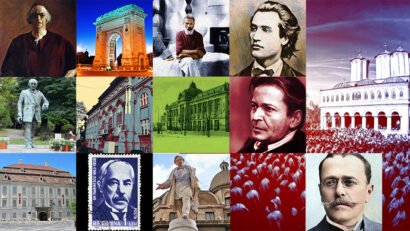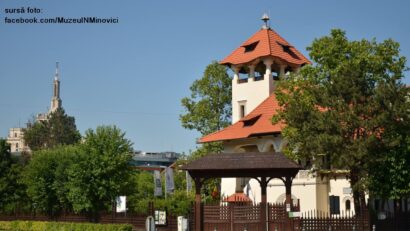Hillel Manoach (1797-1864)
The Sephardic community in multicultural Bucharest produced Hillel Manoach, an influential businessman in the first half of the 19th century

Steliu Lambru, 07.06.2025, 13:00
The Sephardic community in multicultural Bucharest produced Hillel Manoach, an influential businessman in the first half of the 19th century. Manoach was deeply involved in everything that meant the relationship between finances and political projects of the time, the most important being that of building modern Romania. At that time, the Principalities of Moldavia and Wallachia were faced with vital decisions for the continuation of their state existence. And unification was “the keystone without which the entire national edifice would collapse,” as the historian and politician Mihai Kogălniceanu wrote. Hillel Manoach was born at the end of the 18th century in Constantinople, the capital of the Ottoman Empire, the year being uncertain, 1795 or 1797, into the family of a businessman. He and his brother Israel followed their father’s career. They are mentioned both in documents among the creditors of the Wallachian prince Grigorie IV Ghica between 1827-1832, being exempt from taxes for services rendered to the state. In the following years, until the revolution of 1848, Hillel is mentioned as the main creditor of the national guard, the one on the basis of which the modern Romanian army would be established. It should be noted that without his financing, the Wallachian 1848 revolution had little chance of manifesting itself. Later, in the 1850s, he is among those who participate in the development of the banking system, the ancestor of the future financial-banking architecture of Romania. Little known to posterity, the memory of Hillel Manoach is entitled to a restitution. A proverb says “better late than never”, and Felicia Waldman, professor at the University of Bucharest, gives back to the history of Romania the biography of Manoach.
“We know about Hillel Manoach that he was a banker, merchant, philanthropist, financier of the Romanian rulers, but also of the treasuries of the Principalities of Wallachia and Moldavia and, after 1859, of the Romanian state. He was one of the first major Ottoman Sephardic creditors settled in Bucharest; until then, the major moneylenders were from Constantinople. He came from a family of merchants and bankers with financial connections in major European capitals. He was the leader of the Sephardic community in Bucharest, he maintained good relations with the authorities, which allowed him to defend the Ashkenazim as well. He was the personal representative of the sultan in the Romanian Lands. He financed the Revolution of 1848. He was decorated by three emperors, he is the only one in Romanian history to receive decorations from the Tsar of Russia, the Emperor of Austria, and the Ottoman Sultan.”
Like any wealthy and influential man who embraced the ideas of the Enlightenment, Hillel Manoach was a lover of education as a solution to the emancipation of modern man. He passed on these values to his descendants. But noble intentions are not always appreciated by everyone, as was the case with Manoach. Here is Felicia Waldman.
“He was a cultural patron, and his sons, Isac and Emanuel, five years after his death in 1864, when the University of Bucharest was founded, in 1869 donated 100,000 gold lei to it for prizes and scholarships. For 70 years, prizes and scholarships were given from this fund, until 1939, until World War II. On the 70-year list of scholarship holders and awardees, we unfortunately find only 10 Jews, because, for the vast majority of the time, Jews were not allowed access to prizes and scholarships. And some of those who benefited from these scholarships and prizes in the period before and immediately after World War I later became among the biggest anti-Semites in Romania. They lived on Jewish money for a long time in their youth, but then they became anti-Semites. That’s history.”
Like any member of the elite of a country in full modernizing expansion, Manoach had a home in the current center of Bucharest, then the commercial center of the capital. But it disappeared due to subsequent transformations, as Felicia Waldman said.
“The Hillel House no longer exists. Instead, there is Jacques Elias Street. This is a small street that starts right next to the Sfântul Gheorghe-Nou church and continues parallel to the boulevard. Down below, when the passerby walks along Brătianu Boulevard towards Piața Unirii, Elias Street appears, which is not for cars, it is pedestrian. It is a small street, there are two buildings, these are all that there is on it. On the other side of the street there used to be the Hillel Manoach House, which no longer exists today, it is a vacant lot. It is interesting that the street is named after Jacques Elias, who was Hillel Manoach’s grandson. Is it somehow an irony of fate that that building was on the street that bears the grandson’s name or vice versa, the street was named after the person who owned the house. I am convinced that those who gave the name did not know this detail, I am convinced that there is no connection, but it is beautiful as an irony of fate.”
Hillel Manoach found in Romania the homeland in which to place his aspirations, wealth, and efforts for his beliefs in the first half of the 19th century. And even though he faced personal and community unfulfillment, he supported the Romanian project in becoming a viable one.





























